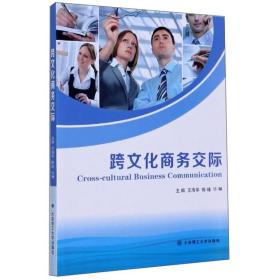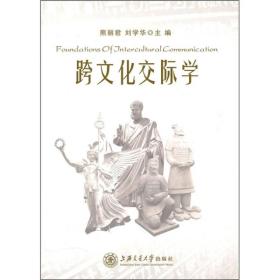
【现货!】跨文化交际教程 余卫华 著 浙江大学出版社
二手会有少量涂画,整体不影响再次阅读使用!套装不一定齐全,请下单前咨询在线客服!
¥ 5.2 1.0折 ¥ 50 八五品
库存15件
作者余卫华 著
出版社浙江大学出版社
ISBN9787308181778
出版时间2019-01
版次1
装帧平装
开本16开
纸张胶版纸
定价50元
货号9787308181778
上书时间2024-12-03
- 在售商品 暂无
- 平均发货时间 8小时
- 好评率 暂无
- 最新上架
商品详情
- 品相描述:八五品
- 商品描述
-
基本信息
书名:跨文化交际教程
定价:50.00元
作者:余卫华 著
出版社:浙江大学出版社
出版日期:2019-01-01
ISBN:9787308181778
字数:
页码:
版次:
装帧:平装
开本:16开
商品重量:
编辑推荐
内容提要
余卫华,谌莉主编的《跨文化交际教程(浙江省普通高校十三五新形态教材)(英文版)》采用全英文编写,目的是希望在提高学习者英语水平的同时培养其跨文化交际能力。教学上拟采用直接法、情境法、案例法、探究法、任务型教学法以及暗示法等方法,充分利用动画、图片、幻灯片、课堂实录、真人情景剧、影视片段等多媒体手段,开展直观教学,并用暗示、联想和问题探究、学生小组讨论和课堂演示等教学方式对学生进行线上和线下以形成性评估为主的考核和评估,使其在轻松愉快的学习过程中获得更好的学习效果。
目录
Chapter 1 Brief Introductioto Intercultural Communicatio 1.1 Culture as Intercultural Communicatio 1.1.1 Two Types of Culture 1.1.2 Five Dimensions of Culture 1.1.3 Characteristics of Culture 1.1.4 Definitioof Intercultural Communicatio 1.2 Approaches to Intercultural Communicatio 1.2.1 Five Elements iCommunicatioProcess 1.2.2 Tips oHow to Communicate Effectively Chapter 2 Verbal and Nonverbal Communicatio 2.1 Introductioto Verbal Communicatio 2.1.1 Role of Language iVerbal Communicatio 2.1.2 Receptive and Productive Language Skills 2.1.3 Need for Using Bias-free Language 2.1.4 Types of Verbal Communicatio 2.2 Introductioto Nonverbal Communicatio 2.2.1 Definitioof Nonverbal Communicatio 2.2.2 Major Types and MaiFeatures of Nonverbal Communicatio 2.3 Major Functions of Nonverbal Communicatio 2.3.1 Nonverbal CommunicatioConveys Meaning 2.3.2 Nonverbal CommunicatioRegulates Conversational Flow 2.3.3 Nonverbal CommunicatioAffects Relationships 2.3.4 Nonverbal CommunicatioExpresses Our Identities 2.4 Deceptioand Nonverbal CommunicatioCompetence 2.4.1 Concept and Misinterpretatioof Deceptio 2.4.2 DeceptioDetecting Abilities and Bias 2.4.3 Misconceptioof Nonverbal Leakage 2.4.4 Typical Giveaway Signs of Deceptio 2.5 Getting Competent 2.5.1 Guidelines to Improve Nonverbal Competence 2.5.2 Applicable Advices iSpecific Channels Complementary 1 : Scripts of JuliaTreasure's TED Lecture---How to Speak So that People Want to Liste Complementary 2: Scripts of Amy Cuddy's TED Lecture--Your Body Language May Shape Who You Are Chapter 3 Communicative Competence and Intercultural CommunicatioCompetence 3.1 Communicating Under Different Cultural Contexts 3.1.1 Differences iGreetings 3.1.2 Differences iApproval and Disapproval Movements Complementary: Signs Not to Use Casually Abroad 3.2 From Communicative Competence to Intercultural CommunicatioCompetence 3.2.1 Framework for Communicative Competence 3.2.2 Concept of Communicative Competence 3.2.3 Concept of Transcultural Competence 3.2.4 Skills of Multilingual Communicators 3.2.5 Components of Intercultural CommunicatioCompetence 3.3 Case Study: Cultural Clashes iJapanese Story 3.4 A Recipe for Successful Intercultural Communicatio 3.4.1 A Heart Set 3.4.2 A Mindset 3.4.3 A Skill Set 3.4.4 Other Practical Approaches 3.5 Culture Shock 3.5.1 Five Phases of Culture Shock 3.5.2 Reverse Culture Shock 3.5.3 Outcomes of the Adjustment Phase 3.5.4 TransitioShock Chapter 4 Stereotype and Prejudice 4.1 Stereotype and Prejudice: AmericaParty 4.1.1 Definitioof Stereotype 4.1.2 Types of Stereotype 4.1.3 Definitioof Prejudice 4.1.4 Ways to Reduce Stereotypes and Prejudices 4.2 Gender Stereotype: Perfect Wome 4.2.1 Definitioof Gender Stereotype 4.2.2 Four Basic Kinds of Gender Stereotype 4.2.3 Stereotype Threat 4.2.4 Impact of Female Stereotype iAncient China 4.2.5 Impact of Female Stereotype iModerChina 4.2.6 Tips for Reducing Gender Stereotype 4.3 Classism: The Poor vs. the Rich 4.3.1 Definitioand Nature of Prejudice 4.3.2 Definitioof Classism 4.3.3 Causes for Prejudice 4.4 Ethnic Prejudice: AfricaAmericans 4.4.1 Definitioof Ethnic Group 4.4.2 Definitioof Ethnic Prejudice 4.4.3 Effects of Prejudice 4.4.4 Strategies for Reducing Ethnic Prejudice Chapter 5 Chinese Culture 5.1 Yellow Civilization: The Loess Plateau 5.1.1 The Loess and the Loess Plateau 5.1.2 Agricultural Civilizatioand Ethnic Integratio 5.1.3 Mellow Civilizatioand National Spirit 5.2 Spiritual Origin: Confucianism 5.2.1 Confucianism, Confucius, and ConfuciaClassics 5.2.2 Confucianism ithe East 5.2.3 Confucianism ithe West 5.3 Chinese Educatio 5.3.1 ConfuciaEducatio 5.3.2 Chinese School System: 1922-1932 5.3.3 Higher EducatioReform After the "Cultural Revolution" 5.4 Yuanming Yua 5.4.1 Constructioof Yuanming Yua 5.4.2 DestructioofYuanming Yua 5.4.3 Mourfor Yuanming Yua 5.5 Chinese Festivals 5.5.1 Spring Festival 5.5.2 LanterFestival 5.5.3 Qingming Festival 5.5.4 DragoBoat Festival 5.5.5 Double Seventh Festival 5.5.6 Mid-autumFestival 5.5.7 Double Ninth Festival 5.5.8 Winter Solstice Festival 5.6 Chinese Cuisine 5.6.1 Chinese Regional Cuisines 5.6.2 Types of Chinese Cuisines 5.6.3 Relatioto Chinese Art 5.7 Chinese Costume--Qipao 5.7.1 History 5.7.2 Origi 5.7.3 VariatioThrough History Chapter 6 WesterCulture 6.1 Blue Civilization: Ancient Greece 6.1.1 Cradle of Blue Civilizatio 6.1.2 History of Ancient Greece 6.1.3 Legacies of Ancient Greece 6.2 Religious Origin: Christianity 6.2.1 Birth of Christianity 6.2.2 Spread and Triumph of Christianity 6.2.3 Impacts of Christianity 6.3 AmericaEducatio 6.3.1 AmericaEducational History 6.3.2 AmericaEducational System 6.3.3 AmericaEducational Hallmarks 6.4 Chateau de Versailles 6.4.1 WesterGardeArt Before Chateau de Versailles 6.4.2 History of Chateau de Versailles 6.4.3 Layout and Features of Chateau de Versailles 6.5 WesterFestival---Christmas 6.5.1 Customs and Traditions 6.5.2 Decorations 6.5.3 Traditional Cuisine 6.5.4 Cards 6.5.5 Gift Giving 6.6 WesterCuisine 6.6.1 Traditional Cuisine 6.6.2 AmericaCuisine 6.7 WesterCostume--Scottish Kilt 6.7.1 History 6.7.2 Desigand Constructio 6.7.3 Fabrics 6.7.4 Setts 6.7.5 Accessories 6.7.6 Contemporary Designs Chapter 7 Globalizatio 7.1 Overview of Globalizatio 7.1.1 Definitioof Globalizatio 7.1.2 Three-tiered Conceptioof Globalizatio 7.2 Economic Globalizatio 7.2.1 Definitioof Economic Globalizatio 7.2.2 Effects of Economic Globalizatio 7.3 Political Globalizatio 7.3.1 Definitioof Political Globalizatio 7.3.2 Impact of Political Globalizatio 7.4 Cultural Globalizatio 7.4.1 Definitioof Cultural Globalizatio 7.4.2 Two Perspectives of Cultural Globalizatio 7.4.3 Impact of Cultural Globalizatio 7.5 Anti-globalizatioMovement 7.5.1 Definitioof Anti-globalizatioMovement 7.5.2 Reasons of Anti-globalizatioMovement 7.5.3 Influence of Anti-globalizatioMovement Chapter 8 Social Identity 8.1 Sports Group: Basketball Game 8.1.1 Definitioof Social Identity 8.1.2 Definitioof Self-concept 8.1.3 Definitioof Self-esteem 8.1.4 Henry Tajfel and His Social Identity Theory 8.1.5 AExample of Social Identity 8.2 Nerdy Guy: SheldoCooper 8.2.1 Definitioof Self-esteem 8.2.2 Tajfel and His Minimal Group Study 8.2.3 Definitioof Positive Distinctiveness 8.2.4 Strategies to Achieve Positive Distinctiveness 8.3 Intergroup Behavior: Immigrants to the US 8.3.1 Interpersonal Behavior and Intergroup Behavior 8.3.2 Definitioof Intergroup Conflict 8.3.3 Realistic Conflict Theory 8.3.4 DefinitioOf Superordinate Goals 8.3.5 Muzafer Sherifand His Robbers Cave Experiment 8.4 Social Identity and Social Compariso 8.4.1 Definitioof Social Group 8.4.2 Definitioof Intergroup Behavior 8.4.3 Understanding of Social Identity 8.4.4 Variables Influencing Intergroup Differentiatio 8.4.5 Social and Instrumental/Realistic CompetitioChapter 9 Global Citizenship 9.1 Global Citizenship 9.1.1 Definitioof Global Citizenship 9.1.2 Origiof Global Citizenship 9.1.3 Global Citizenship iOther Context 9.1.4 Concept of"Glocalization" 9.2 Global Citizenship Educatio 9.2.1 Definitioof Global Citizenship Educatio 9.2.2 CommoPerspectives oGCE 9.2.3 Pedagogical Features of GCE 9.3 Themes, Outlooks, and Skills for Global Citizenship 9.3.1 Core Themes of Global Citizenship 9.3.2 Outlooks of Global Citizenship 9.3.3 Skills Needed for Global Citizenship MaiReferences Appendices
作者介绍
序言
-

【封面】
相关推荐
— 没有更多了 —




















以下为对购买帮助不大的评价